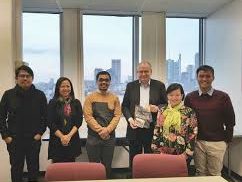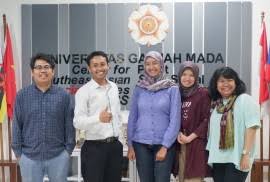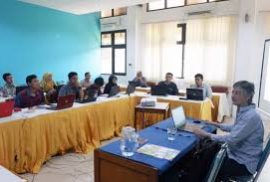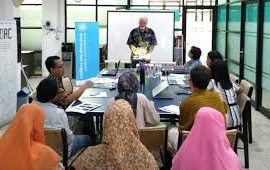After working hard from August to November to realize the World Class Professor (WCP)Program of Ministry of Research, Technology, and Higher Education, Center for Southeast Asian Social Studies (CESASS) UGM, Center for Coastal Rehabilitation and Disaster Mitigation Studies (CoREM) of Universitas Diponegoro, and Tsunami Disaster Mitigation Research Center (TDMRC) of Universitas Syiah Kuala held a research seminar themed “Ecological Communication on Maritime Disaster Management in Southeast Asia” at the Faculty of Engineering, Universitas Mataram (15/12/2017).
Activity
One effort to develop the capacity and performance of an institution is to build cooperation with other institutions. This is also done by the Centre for Southeast Asian Social Studies (CESASS) UGM which started the cooperation with the Department of Southeast Asian Studies, Goethe Universität Frankfurt am Main (7/12/2017). Head of CESASS, Dr.phil. Hermin Indah Wahyuni accompanied by researcher of CESASS, Dr. Agus Suwignyo, Dr. phil. Vissia Ita Yulianto, Andi Awaluddin Fitrah, M.A., Aditya Indra Nugraha, S.Ant, and Fitri Handayani, S.I.P. met the Head of Department of Southeast Asian Studies of Goethe Universität Frankfurt am Main, Prof. Dr. Arndt Graf.
As a form of reciprocity towards the process of exchanging knowledge and joint publication, the research team of Centre for Southeast Asian Social Studies (CESASS) Universitas Gadjah Mada visited Germany from the 25th November 2017 till the 8th December 2017. The visit was a response visit, as 2 German professors had initially made a visit, Prof. Thomas Hanitzsch (Ludwig-Maximilians-Universitӓt Müchen) and Prof. Judith Schlehe (Albert-Ludwigs University of Freiburg), whom were the visiting professors for the World Class Professor (WCP) program by Kemenristekdikti.
In the 12th Jogja-Netpac Asian Film Festival 2017, JAFF collaborated with Centre for Southeast Asian Social Studies (CESASS) Universitas Gadjah Mada to present the “Public Lecture” program. This year’s Public Lecture was special as it included research poster presentations regarding cinemas in Asia which was organized by CESASS UGM. The results, 9 presenters were chosen from Indonesia, Malaysia and the Philippines that took part in the event.
This Public Lecture program was conducted from the 4th till the 6th of December 2017, at the 2nd Floor Seminar Room in the UGM’s main library. Consisted of six sessions spread throughout the three-days event, which comprised of the; seminar, discussion, book launching, and research poster presentations. The themes discussed within the forum is in line with this year’s theme “Fluidity” taking the example of “Film and Art Performance”, “Indonesian Film Audience”, “Asia Pacific in the Digital World”, “Distribution and Film Funding”, “ASEAN Identity in the Short Films”, and discussion about the book of Film, Ideology and Military written by Budi Irwanto and Cultural Specificity in Indonesian Film: Unity in Diversity written by David Hanan
Just as the rain stopped, Prof. Cherian George, a professor in the Communication Department in Hong Kong Baptist University, stepped into the office of Centre for Southeast Asian Social Studies (CESASS) Universitas Gadjah Mada (23/11/2017). This visit of a Singaporean Professor in Yogyakarta was as a speaker at the International Seminar on Social and Political Science (ISSOCP) 2017 which is part of the celebration of the 62nd Anniversary of Faculty of Social and Political Sciences (FISIPOL) Universitas Gadjah Mada at University Club UGM on the 23rd-24th November 2017.
Knowledge of all sort should not only be passed from universities to the public, but should too be shared between universities as so to learn from one another in order to enhance the capacity and capability as an institution. As the only leading center of excellence (Pusat Unggulan Ipteks Perguruan Tinggi – PUI-PT) in the aspect of social sciences, Centre of Southeast Asian Social Studies (CESASS) Universitas Gadjah Mada received a visit from a representative of Universitas Negeri Malang (UM), Mr. Arda Purnama Putra, M. Pd. The purpose of his visit to CESASS UGM is to study the management of PUI-PT.
In the digital era, invasion of fake news and hoax are densely correlated with political interest which has caused uneasiness towards journalist scholars. At this time, the study of investigative journalism becomes suitable to be further discussed in order to asses the ability of the media to criticize in facing fake news and hoax which has spread widely in the media. Such circumstance has caused problem towards journalist activities in this Post-Truth era. Post-Truth era is a phase where the spread of news which seems true, yet it is actually not. In the year 2016, the term Post-Truth became the words of the year by Oxford Dictionary.
Our world has been greatly traumatized by war. The history of modernity has begun since the post-medieval era marked by colonialism and imperialism. Modernization of the concept of war itself was evident during the world war in the early 20th century, till the cold war in the year 1960. The word “war” becomes a specter that terrifies and concerns for it to not reoccur. Unfortunately, the rise of numbers of developed countries comes together with the production of nuclear weapons. With the purpose in maintaining security and sovereignty of their country, nuclear is seen as a solid ford to intimidate their counterpart. The matter that is becoming an alarming issue is the fact that nuclear testing program is taking place in countries beyond the territory of the country that created it, thus bringing upon immense damage towards the people within the host country of the testing program.
The concept of remote sensing is very closely related with sciences, in particularly with the study of Geography and Geology. However, what if remote sensing could be applied to social sciences?
Centre for Southeast Asian Social Studies (CESASS) UGM organised a workshop with the theme “Geographical Information System Application on Social Sciences”, with Prof. Magaly Koch, Ph. D from Center for Remote Sensing, Boston University, United States which was held in the Ruang Indonesia, CESSAS UGM (6/11/2017). This workshop is part of the World Class Professor (WCP) program from the Ministry of Research, Technology and Higher Education of the Republic of Indonesia which was hosted by the consortium of CESASS UGM, Center for Costal Rehabilitation and Disaster Mitigation Studies Universitas Diponegoro and Center for Tsunami and Disaster Mitigation Universitas Syiah Kuala. Prof. Magaly herself is a visiting professor in the Center for Costal Rehabilitation and Disaster Mitigation Studies Universitas Diponegoro.
It is without a doubt that the media has played a significant contribution towards informing issues relating to the environment, from climate change, global warming, to maritime disaster. With this, the communication perspective is needed to explain how communicative action can result in a public sphere that accommodates environmental issues to create a sensitive society.
Center for Southeast Asian Social Studies (CESASS) Universitas Gadjah Mada had another visiting professor which is part of the World Class Professor (WCP) that is sponsored by the Ministry of Research, Technology and Higher Education of the Republic of Indonesia. The third professor to be working with the researcher in CESSAS UGM is Prof. Dr. David Robie from Auckland University of Technology (AUT), New Zealand. He specializes in the aspect of Journalism particularly in environmental issues. Apart from academic, Prof. David is in fact a Greenpeace journalist and activist. He is a living legend for the sunken Rainbow Warrior ship case in pacific. Rainbow Warrior is a Greenpeace ship conducting an anti-nuclear testing protest which was sunken by the French intelligence in the Pacific Ocean.








